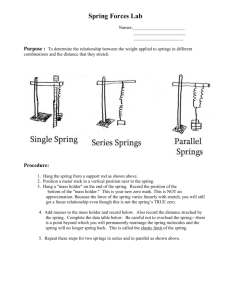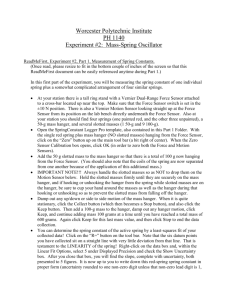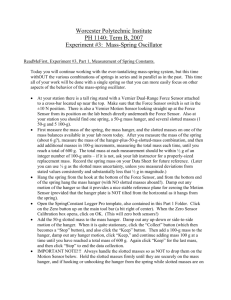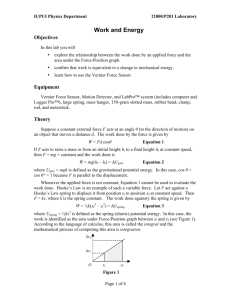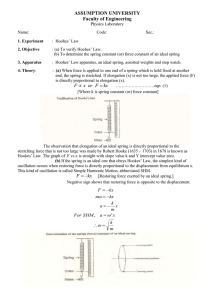Lab 1
advertisement
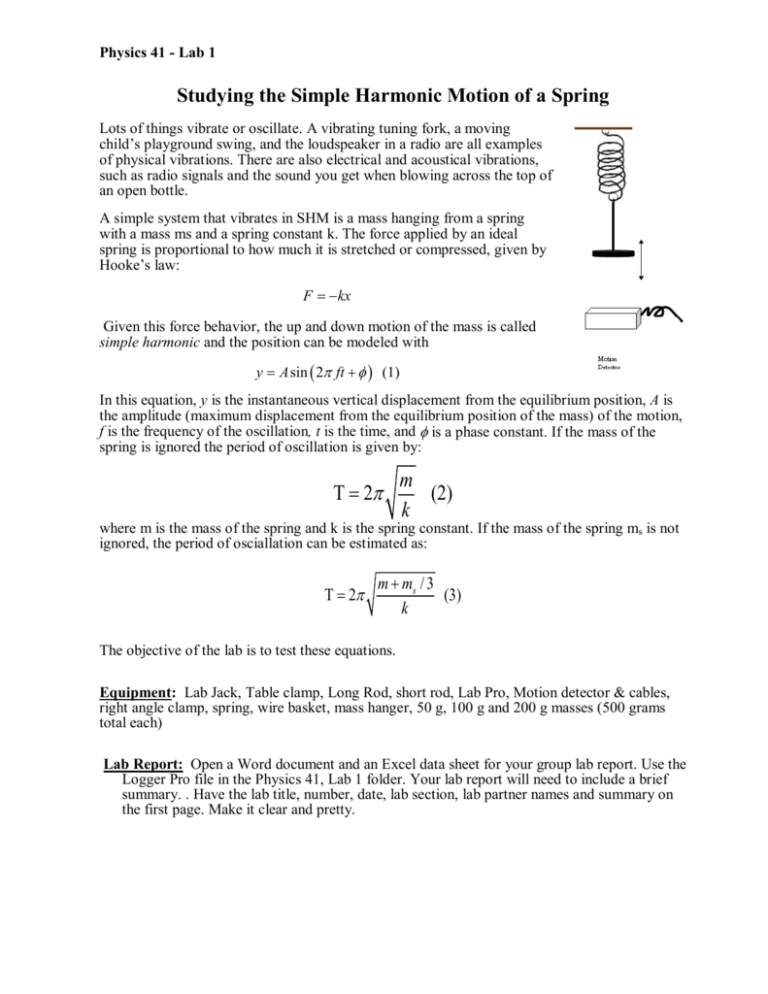
Physics 41 - Lab 1 Studying the Simple Harmonic Motion of a Spring Lots of things vibrate or oscillate. A vibrating tuning fork, a moving child’s playground swing, and the loudspeaker in a radio are all examples of physical vibrations. There are also electrical and acoustical vibrations, such as radio signals and the sound you get when blowing across the top of an open bottle. A simple system that vibrates in SHM is a mass hanging from a spring with a mass ms and a spring constant k. The force applied by an ideal spring is proportional to how much it is stretched or compressed, given by Hooke’s law: F = −kx Given this force behavior, the up and down motion of the mass is called simple harmonic and the position can be modeled with y A sin ( 2π ft + φ ) (1) = In this equation, y is the instantaneous vertical displacement from the equilibrium position, A is the amplitude (maximum displacement from the equilibrium position of the mass) of the motion, f is the frequency of the oscillation, t is the time, and φ is a phase constant. If the mass of the spring is ignored the period of oscillation is given by: Τ =2π m (2) k where m is the mass of the spring and k is the spring constant. If the mass of the spring ms is not ignored, the period of osciallation can be estimated as: Τ =2π m + ms / 3 (3) k The objective of the lab is to test these equations. Equipment: Lab Jack, Table clamp, Long Rod, short rod, Lab Pro, Motion detector & cables, right angle clamp, spring, wire basket, mass hanger, 50 g, 100 g and 200 g masses (500 grams total each) Lab Report: Open a Word document and an Excel data sheet for your group lab report. Use the Logger Pro file in the Physics 41, Lab 1 folder. Your lab report will need to include a brief summary. . Have the lab title, number, date, lab section, lab partner names and summary on the first page. Make it clear and pretty. Experimental Procedure 1. Weigh the mass of the spring and the mass hanger and put this data into your lab report. Attach the spring to a horizontal rod connected to the lab stand with the denser part of the spring at the top. Hang the mass hanger from the spring on it as shown above. 2. Connect the Motion Detector to DIG/SONIC 1 of the LabPro 3. Place the Motion Detector at least 75 cm below the mass. Make sure there are no objects near the path between the detector and mass, such as a table edge. Place the wire basket over the Motion Detector to protect it. Open the Logger Pro file from Physics 41 SHM folder. 4. Make a preliminary run to make sure things are set up correctly. Lift the mass upward a few to centimeters and release. The mass should oscillate along a vertical line only. Click begin data collection. The position graph should show a clean sinusoidal curve. If it has flat regions or spikes, reposition the Motion Detector and try again. Part 1: Finding the Spring Constant 1. Set the equilibrium position of the spring – hanger system by zeroing the motion detector. . Do this by allowing the mass to hang free and at rest. The zero is under the experiment menu in Logger Pro. Collect data to confirm that the motion detector is reading the bottom of the hanger as the zero point. 2. Add 100 grams to mass hanger and let the spring system come to rest. Measure the distance to the hanger by collecting data. THE MASS IN NOT OSCILLATING!!!! Use the statistics analysis to find the mean value of the distance. Copy and paste a sample logger pro graph into your report. Repeat for 100 g increments for a total of 5 data points. Calculate the value of k for each weight and displacement. USE EXCEL FORMULAS to do the calculations. Copy and paste the formulas as text to show that you did it.. Average the values of k and find the average deviation between them. This will be the uncertainty in your k. Plot the applied force (the added weights) vs the displacement and do a linear fit to find the slope of the line. This will give you the force constant, k, for the spring. Copy and paste the F vs x graph into your lab along with the linear fit information. Write the value of k in standard form: k ± ∆k Part 1: Finding the Period of Oscillation 1. Now remove all but 100 g from the hanger. Lift the mass upward about 5 cm and release it. to collect data. Examine The mass should oscillate along a vertical line only. Click the graphs. The pattern you are observing is characteristic of simple harmonic motion. Use a stop watch to determine the period. Enter that into your data table. Do a sinusoidal curve fit for the graph. Copy and paste the graph and function into your lab report. Rewrite the curve fit so that it has the same form as equation (1). Find the period and frequency of the mass spring system from the coefficient of t in the sin function. Show your work. You only have to rewrite the equation and show the work to find the period once. 2. Repeat with 200 g, 300 g, 400 g and 500 g or 4 more mass combinations on the hanger. For each weight, find the period from the sin function. Enter this into your table. 3. Calculate period of spring-hanger system for each weight using the k you derived above and equations 2 and 3. USE EXCEL FORMULAS to do the calculations. Copy and paste the formulas as text to show that you did it. Make sure you include the mass of the hanger!! Find the percent difference between the experimental value you found for the period and the periods calculated with equations 2 and 3 for each mass. Find an average percent difference. 4. Which equation gave the best agreement with experimental values? How does the agreement change with increasing mass? Or does it? Write as summary of your results. Print out your data sheet and graphs. Have the lab title, number, date, lab section, lab partner names and summary on the first page. Make it clear and pretty.



